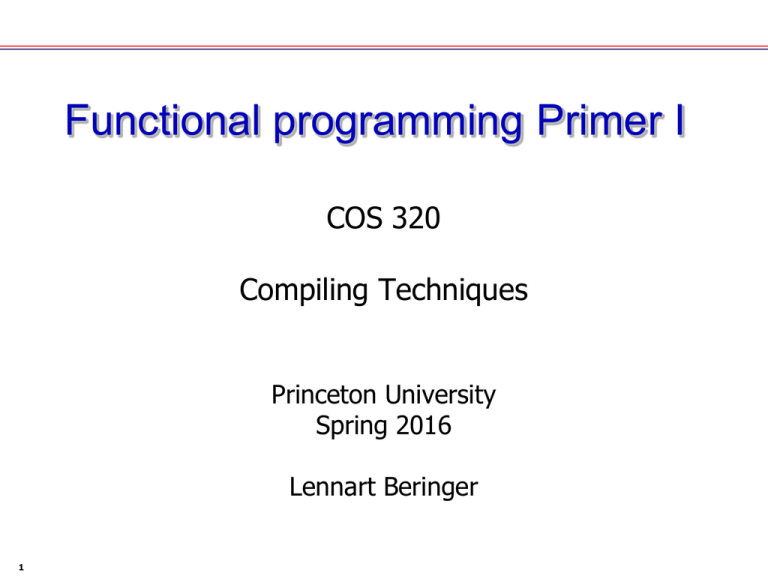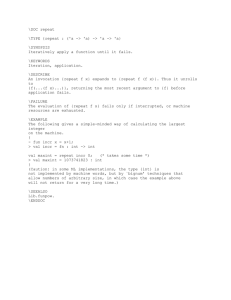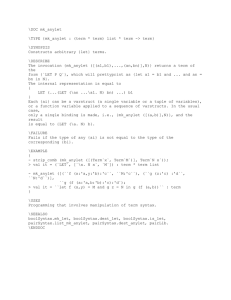Functional programming Primer I COS 320 Compiling Techniques Princeton University
advertisement

Functional programming Primer I
COS 320
Compiling Techniques
Princeton University
Spring 2016
Lennart Beringer
1
Characteristics of functional programming
• Primary notions:
functions and expressions (not commands);
• Primary operations (not sequencing):
• expression evaluation
• function formation and application
• expression evaluation in (top-level) interpreter: - 3+4;
• binding value to an identifier: - val x = 3+4;
Basic function formation:
fun SimpleCompiler (input) = backend (frontend (input))
(types often inferred from types of operands and arguments)
Or: val SimpleCompiler = fn input => (backend o frontend) (input)
2
Characteristics of functional programming cont’d
Guiding principles:
• generally avoid side-effects whenever possible (exception: IO, …)
• referential transparency: can substitute expression that yield equal results
•
•
•
•
•
•
•
•
•
Variables act as names, not storage cells (registers)
Statically typed: eliminates many programming mistakes
Higher-order functions (functions as args & return values)
Inductive data types, pattern matching
Parametric polymorphism, with type inference
(possibly mutually) recursive functions instead of loops
disciplined model of memory and exceptions
expressive module system
Libraries:
• SML Base library: http://sml-family.org/Basis
• SMLNJ library: http://www.smlnj.org/doc/smlnj-lib
3
ML interpreter’s evaluation environment
Declarations are interpreted in context of previous declarations
• top-level declarations push item onto “stack” but no pop operation
• later declarations use most recent declaration
x: 5.0, real
val x = 5;
…
fun addx y = x+y;
…
x: 5, int
addx: .., .=>.
…
x: 5, int
val x = 5.0;
addx: .., .=>.
…
x: 5, int
• a local declaration like let val x = e1 in e2 end temporarily extends
the current environment with a binding for x for the duration of e2, so
pops the binding for x from stack after e2 has finished
4
Composite expression formation: let-binding
• Naming of intermediate values, with explicit scope
expression involving
expression that may
previously introduced names
also mention n
let val n = e1 in e2 end
• Scope of n is e2: if there’s another surrounding introduction
of n, the “local” n hides the outer one only for the duration
of e2 (“outer” n is reestablished after e2).
• n is bound (to the value resulting from evaluating e1) in e2
5
Bound and free occurrences of variables
• Let-bindings, function parameters, and pattern matches
(below) bind variables/names in their respective scope.
• Occurrences of variables that are not bound are free.
• Note: an expression may contains bound and free
occurrences of the same name.
Example:
let x = let x = x*x in x+y end
in let x = x+1 in x end
end
Informal disambiguation:
let x = let x = x*x in x+y end
in let x = x+1 in x end
end
6
α-renaming
• Renaming a bound variable does not change the
meaning of an expression
Example:
let x = let x = x*x in x+y end
in let x = x+1 in x end
end
Informal disambiguation:
let x = let x = x*x in x+y end
in let x = x+1 in x end
end
let a = let z = x*x in z+y end
in let b = a+1 in b end
end
(one aspect of referential transparency)
7
ML types
• Base types:
• int: (example values: 1, 4, ~3, 0)
• reals (example values: 0.0, 3.5, 1.23E~10)
• Strings (“abc\n”)
• Tuples/products: A * B (in general: A1 * … * An)
• formation (1, 3.5) : int * real
• elimination: fst p, snd p, #i p
• empty product: unit, with value ()
• Function space A -> B
• formation: fn (x:A):B => e
• elimination: application f e
• Records: { lab1:A1, …, labn:An } (order “irrelevant”)
• Polymorphic types (types containing type variables ‘a, ‘b…)
• occur typically in combination with (higher-order) functions, and
inductive datatypes
8
Inductive data types
Example: (polymorphic) binary trees
• Definition of recursive, polymorphic type:
datatype ’a bintr = LEAF of ’a | NODE of ’a bintr * ’a bintr;
9
Inductive data types
Example: (polymorphic) binary trees
• Definition of recursive, polymorphic type:
datatype ’a bintr = LEAF of ’a | NODE of ’a bintr * ’a bintr;
• Constructing values using constructors
LEAF: ’a => ‘a bintree and NODE: ’a bintr * ’a bintr => ‘a bintr
Example: val mytree1 = LEAF 1; (*yields mytree1: int bintr*)
10
Inductive data types
Example: (polymorphic) binary trees
• Definition of recursive, polymorphic type:
datatype ’a bintr = LEAF of ’a | NODE of ’a bintr * ’a bintr;
• Constructing values using constructors
LEAF: ’a => ‘a bintree and NODE: ’a bintr * ’a bintr => ‘a bintr
Example: val mytree1 = LEAF 1; (*yields mytree1: int bintr*)
• Destructing/inspecting values by pattern matching
fun height t = case t of LEAF l => 1
| NODE (left, right) => 1 + max (height l, height r);
(*yields val height = fn : ‘a bintree -> int*)
11
Inductive data types
Example: (polymorphic) binary trees
• Definition of recursive, polymorphic type:
datatype ’a bintr = LEAF of ’a | NODE of ’a bintr * ’a bintr;
• Constructing values using constructors
LEAF: ’a => ‘a bintree and NODE: ’a bintr * ’a bintr => ‘a bintr
Example: val mytree1 = LEAF 1; (*yields mytree1: int bintr*)
• Destructing/inspecting values by pattern matching
fun height t = (case t of LEAF l => 1
| NODE (left, right) => 1 + max (height l, height r));
(*yields val height = fn : ‘a bintree -> int*)
recommendation: add parens!
12
Inductive data types
Example: (polymorphic) binary trees
• Definition of recursive, polymorphic type:
datatype ’a bintr = LEAF of ’a | NODE of ’a bintr * ’a bintr;
• Constructing values using constructors
LEAF: ’a => ‘a bintree and NODE: ’a bintr * ’a bintr => ‘a bintr
Example: val mytree1 = LEAF 1; (*yields mytree1: int bintr*)
• Destructing/inspecting values by pattern matching
fun height t = (case t of LEAF l => 1
| NODE (left, right) => height l + height r);
(*yields val height = fn : ‘a bintree -> int*)
recommendation: add parens!
• Datatypes don’t need to be recursive, 0-ary constructors ok:
datatype colors = RED | GREEN | BLUE;
13
Higher-order and mutually recursive functions
• Can use functions as parameters/arguments and return
values of functions
fun twice f x = f (f x); (*yields val twice = fn : (‘a -> ‘a) -> ‘a -> ‘a*)
fun add x = fn y -> x+y; (*yields val add = fn: int -> int -> int *)
val h = twice (add 3); (*yields val h = fn: int -> int *)
val z = h 7; (*yields val z = 13*)
• Definition of mutually recursive functions (used in parser)
14
datatype nat = Succ of nat | Zero;
fun even n = (case n of Zero => true | Succ m => odd m)
and odd n = (case n of Zero => false | Succ m => even m);
val SEVEN = Succ (… (Succ Zero)…);
even SEVEN;
Boolean conjunction is called andalso, not and
Higher-order and mutually recursive functions
• Can use functions as parameters/arguments and return
values of functions
fun twice f x = f (f x); (*yields val twice = fn : (‘a -> ‘a) -> ‘a -> ‘a*)
fun add x = fn y -> x+y; (*yields val add = fn: int -> int -> int *)
val h = twice (add 3); (*yields val h = fn: int -> int *)
val z = h 7; (*yields val z = 13*)
• Definition of mutually recursive functions (used in parser)
15
datatype nat = Succ of nat | Zero;
fun even n = (case n of Zero => true | Succ m => odd m)
and odd n = (case n of Zero => false | Succ m => even m);
val SEVEN = Succ (… (Succ Zero)…);
even SEVEN;
Boolean conjunction is called andalso, not and
References in ML
Type of “mutable references of type T”: ref T
• can hold values of type T
16
References in ML
Type of “mutable references of type T”: ref T
• can hold values of type T
• creation-”allocation+initialization”: ref e, where e:T
holds, i.e. e is an expression of type T
• evaluate e to a value v; then put v into a fresh ref cell
• typical use: let val x = ref e in … end
• type T has certain restrictions regarding polymorphism…
17
References in ML
Type of “mutable references of type T”: ref T
• can hold values of type T
• creation-”allocation+initialization”: ref e, where e:T
holds, i.e. e is an expression of type T
• evaluate e to a value v; then put v into a fresh ref cell
• typical use: let val x = ref e in … end
• type T has certain restrictions regarding polymorphism…
• read access: !e, where e:ref T
• evaluate e to a value v (v: ref T will be satisfied!)
• return the content u of cell v. u:T will hold!
18
References in ML
Type of “mutable references of type T”: ref T
• can hold values of type T
• creation-”allocation+initialization”: ref e, where e:T
holds, i.e. e is an expression of type T
• evaluate e to a value v; then put v into a fresh ref cell
• typical use: let val x = ref e in … end
• type T has certain restrictions regarding polymorphism…
• read access: !e, where e:ref T
• evaluate e to a value v (v: ref T will be satisfied!)
• return the content u of cell v. u:T will hold!
• write access: e:=e’ where e:ref T and e’:T
• evaluate e and e’, yielding values v: ref T and v’:T
• store v’ in v. Type of ref-cell remains unmodified!
19
References in ML
Type of “mutable references of type T”: ref T
• can hold values of type T
• creation-”allocation+initialization”: ref e, where e:T
holds, i.e. e is an expression of type T
• evaluate e to a value v; then put v into a fresh ref cell
• typical use: let val x = ref e in … end
• type T has certain restrictions regarding polymorphism…
• read access: !e, where e:ref T
• evaluate e to a value v (v: ref T will be satisfied!)
• return the content u of cell v. u:T will hold!
• write access: e:=e’ where e:ref T and e’:T
• evaluate e and e’, yielding values v: ref T and v’:T
• store v’ in v. Type of ref-cell remains unmodified!
No uninitialized memory cells! No nil pointers – no nil pointer exceptions!
Content guaranteed to be type-correct: no casting
20
Practicalities
• Loading files:
• - use myfile.sml;
• myfile.sml may include subordinate use statements
• Opening (library) structures: - open Math;
• Quitting the interpreter:
Unix: ctrl-D
Windows: ctrl-Z
Or call OS.Process.exit(OS.Process.success);
• Emacs mode: see info pages of SMLNJ
Compilation manager CM: see assignment1
21
Comprehensive details
http://www.cs.cmu.edu/~rwh/smlbook
Cambridge University Press
PU library
22
More links to books and doc
at http://www.smlnj.org





